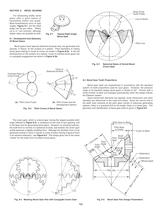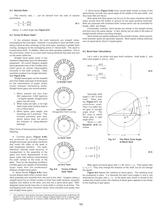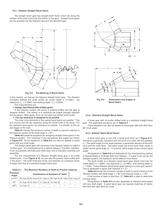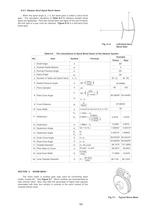
Catalog excerpts

Fig. 8-1 Typical Right Angle Bevel Gear SECTION 8 BEVEL GEARING For intersecting shafts, bevel gears offer a good means of transmitting motion and power. Most transmissions occur at right angles, Figure 8-1 , but the shaft angle can be any value. Ratios up to 4:1 are common, although higher ratios are possible as well. 8.1 Development And Geometry Of Bevel Gears OP Great Circle Tooth ProfileLine of Action Pitch Line Bevel gears have tapered elements because they are generated and operate, in theory, on the surface of a sphere. Pitch diameters of mating bevel gears belong to frusta of cones, as shown in Figure 8-2a . In the full development on the surface of a sphere, a pair of meshed bevel gears are in conjugate engagement as shown in Figure 8-2b . The crown gear, which is a bevel gear having the largest possible pitch angle (defined in Fig. 8-4 Spherical Basis of Octoid Bevel Crown Gear Figure 8-5 . Common Apex of Cone FrustaTrace of Spherical Surface W > 2 8.2 Bevel Gear Tooth Proportions OO"O'P' G > 2 G Bevel gear teeth are proportioned in accordance with the standard system of tooth proportions used for spur gears. However, the pressure angle of all standard design bevel gears is limited to 20. Pinions with a small number of teeth are enlarged automatically when the design follows the Gleason system. Since bevel-tooth elements are tapered, tooth dimensions and pitch diameter are referenced to the outer end (heel). Since the narrow end of the teeth (toe) vanishes at the pitch apex (center of reference generating sphere), there is a practical limit to the length (face) of a bevel gear. The geometry and identification of bevel gear parts is given in > 1 W > 1 Pitch Cone Frusta (b) Pitch Cones and the Development Sphere Figure 8-4 . This shape gives rise to the name "octoid" for the tooth form of modern bevel gears. Fig. 8-2 Pitch Cones of Bevel Gears(a) Figure 8-3 ), is analogous to the rack of spur gearing, and is the basic tool for generating bevel gears. However, for practical reasons, the tooth form is not that of a spherical involute, and instead, the crown gear profile assumes a slightly simplified form. Although the deviation from a true spherical involute is minor, it results in a line-of-action having a figure-8 trace in its extreme extension; see > Cone Dist.Face Pitch AnglePitch Angle AddendumDedendumWhole Depth Pitch Apex to BackPitch Apex to CrownCrown to BackPitch ApexShaft Angle Pitch Dia. O.D. Root AngleFace Angle Fig. 8-3 Meshing Bevel Gear Pair with Conjugate Crown Gear O > 2 2 PO PO > Back Cone Dist. O > 1 1 O Fig. 8-5 Bevel Gear Pair Design Parameters >
Open the catalog to page 1
8.5 Bevel Gear Calculations Let z Zerol bevels ( Figure 8-6d ) have curved teeth similar to those of the spiral bevels, but with zero spiral angle at the middle of the face width; and they have little end thrust. Both spiral and Zerol gears can be cut on the same machines with the same circular face-mill cutters or ground on the same grinding machines. Both are produced with localized tooth contact which can be controlled for length, width, and shape. Functionally, however, Zerol bevels are similar to the straight bevels and thus carry the same ratings. In fact, Zerols can be used in the...
Open the catalog to page 2
8.5.1 Gleason Straight Bevel Gears The straight bevel gear has straight teeth flanks which are along the surface of the pitch cone from the bottom to the apex. Straight bevel gears can be grouped into the Gleason type and the standard type. In this section, we discuss the Gleason straight bevel gear. The Gleason Company defined the tooth profile as: whole depth R > e bdd R > e 8.5.2. Standard Straight Bevel Gears d b > i a A bevel gear with no profile shifted tooth is a standard straight bevel gear. The applicable equations are in A spiral bevel gear is one with a spiral tooth flank as in d...
Open the catalog to page 3
When the spiral angle B > m = 0, the bevel gear is called a Zerol bevel gear. The calculation equations of Table Figure 8-12 8-2 for Gleason straight bevel gears are applicable. They also should take care again of the rule of hands; left and right of a pair must be matched. is a left-hand Zerol bevel gear. Addendum Angle Fig. 8-12 Left-Hand Zerol Bevel Gear Example Pinion Gear Table 8-6 The Calculations of Spiral Bevel Gears of the Gleason System ItemNo. Symbol Formula Shaft Angle Outside Radial ModuleNormal Pressure AngleSpiral AngleNumber of Teeth and Spiral HandRadial Pressure AnglePitch...
Open the catalog to page 6All Quality Transmission Components catalogs and technical brochures
-
KSUW1.5-R1
1 Pages
-
KKRCPFD10-1000J
1 Pages
-
KSAM1.5-20045
1 Pages
-
KSH2-20R
1 Pages
-
KSS0.5-30C
1 Pages
-
DIAMETRAL PITCH GEAR
34 Pages
-
Q420 Catalog
526 Pages
-
TOOTH THICKNESS
16 Pages
-
SPUR GEAR CALCULATIONS
5 Pages
-
DETAILS OF INVOLUTE GEARING
1 Pages
-
Introduction to Metric Gears
15 Pages
-
DESIGN OF PLASTIC GEARS
15 Pages
-
WORM GEARING
5 Pages
-
HELICAL GEARS
6 Pages
-
INTERNAL GEARS
4 Pages
























